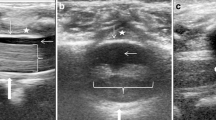Abstract
Background
The safety and efficacy of US-guided lumbar puncture in children has been described. In the pediatric setting, children are frequently referred to interventional radiology only after a failed landmark-based attempt. Routine pre-procedure US in these children is useful to determine a safe level for subarachnoid access and to optimize success.
Objective
To determine whether pre-procedure US improves technical success and safety of US-guided lumbar puncture.
Materials and methods
We included 47 children. Inclusion criteria were urgent US-guided lumbar puncture in pediatric patients <18 years old. Exclusion criteria were non-urgent lumbar punctures, children referred without an antecedent landmark-based attempt, lumbar punctures performed with fluoroscopic guidance, and procedures performed prior to introducing the diagnostic approach in 2017. We did not evaluate data pertaining to successful landmark-based lumbar punctures performed without subsequent need for additional attempts. We recorded technical successes, adverse events and relevant abnormalities identified on pre-procedural US.
Results
Thirty-six US-guided lumbar punctures were performed with 100% technical success. Eleven children referred to interventional radiology did not undergo lumbar puncture because of unfavorable US findings or interval clinical improvement obviating the need for lumbar puncture. Thirty-six children underwent US evaluation of the thecal sac prior to potential intervention. Of these 36 with pre-procedural US studies, 12 demonstrated paucity of cerebrospinal fluid and 14 demonstrated an epidural hematoma. Fifteen children who underwent lumbar puncture had a “traumatic tap,” classified as a mild adverse event. No moderate or severe adverse events were recorded.
Conclusion
Limited spinal US following failed landmark-based lumbar punctures frequently identifies procedure-related complications and can augment patient selection for future image-guided lumbar punctures.


Similar content being viewed by others
References
Cauley KA (2015) Fluoroscopically guided lumbar puncture. AJR Am J Roentgenol 205:W442–W450
An CJE, Ogilvy CS (2001) Fluoroscopy-guided lumbar puncture: decreased frequency of traumatic tap and implications for the assessment of CT-negative acute subarachnoid hemorrhage. AJNR Am J Neuroradiol 22:571–576
Brenner DJ, Hall EJ (2007) Computed tomography — an increasing source of radiation exposure. N Engl J Med 357:2277–2284
Pierce DB, Shivaram G, Koo KSH et al (2018) Ultrasound-guided lumbar puncture in pediatric patients: technical success and safety. Pediatr Radiol 48:875–881
Wang PI, Wang AC, Naidu JO et al (2013) Sonographically guided lumbar puncture in pediatric patients. J Ultrasound Med 32:2191–2197
Coley BD, Shiels WE II, Hogan MJ (2001) Diagnostic and interventional ultrasonography in neonatal and infant lumbar puncture. Pediatr Radiol 31:399–402
Bonadio W (2014) Pediatric lumbar puncture and cerebrospinal fluid analysis. J Emerg Med 46:141–150
Neal JT, Kaplan SL, Woodford AL et al (2017) The effect of bedside ultrasonographic skin marking on infant lumbar puncture success: a randomized controlled trial. Ann Emerg Med 69:610–619.e1
Vandenbroucke JP, von Elm E, Altman DG et al (2007) Strengthening the reporting of observational studies in epidemiology (STROBE): explanation and elaboration. PLoS Med 4:e297
American Institute of Ultrasound in Medicine, American College of Radiology, Society for Pediatric Radiology, Society of Radiologists in Ultrasound (2012) AIUM practice guideline for the performance of an ultrasound examination of the neonatal spine. J Ultrasound Med 31:155–164
Harrison D, Stevens B, Bueno M et al (2010) Efficacy of sweet solutions for analgesia in infants between 1 and 12 months of age: a systematic review. Arch Dis Child 95:406–413
Mazor SS, McNulty JE, Roosevelt GE (2003) Interpretation of traumatic lumbar punctures: who can go home? Pediatrics 111:525–528
Khalilzadeh O, Baerlocher MO, Shyn PB et al (2017) Proposal of a new adverse event classification by the Society of Interventional Radiology Standards of practice committee. J Vasc Interv Radiol 28:1432–1437.e3
Muthusami P, Robinson AJ, Shroff MM (2017) Ultrasound guidance for difficult lumbar puncture in children: pearls and pitfalls. Pediatr Radiol 47:822–830
Öncel S, Günlemez A, Anik Y, Alvur M (2013) Positioning of infants in the neonatal intensive care unit for lumbar puncture as determined by bedside ultrasonography. Arch Dis Child Fetal Neonatal Ed 98:F133–F135
Honarbakhsh S, Osman C, Teo JT, Gabriel C (2013) Ultrasound-guided lumbar puncture as a diagnostic aid to reduce number of attempts and complication rates. Ultrasound 21:170–175
Author information
Authors and Affiliations
Corresponding author
Ethics declarations
Conflicts of interest
Jeffrey Forris Beecham Chick is a consultant and speaker for Guerbet and C. R. Bard. Eric J. Monroe is a scientific advisor and speaker for Biogen.
Additional information
Publisher’s note
Springer Nature remains neutral with regard to jurisdictional claims in published maps and institutional affiliations.
Electronic supplementary material
ESM 1
(DOCX 11 kb)
Rights and permissions
About this article
Cite this article
Jeyakumar, A., Weaver, J.J., Chick, J.F.B. et al. Spinal ultrasound after failed landmarked-based lumbar puncture: a single institutional experience. Pediatr Radiol 51, 289–295 (2021). https://doi.org/10.1007/s00247-020-04831-w
Received:
Revised:
Accepted:
Published:
Issue Date:
DOI: https://doi.org/10.1007/s00247-020-04831-w




